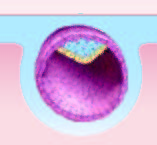Embryo glue
IVF technologies and developments are considered one of the most useful technical and scientific revolutions at the medical and social levels, because it mimic the natural instinct and it concentrate on one aim which is for parents to have a baby.
EmbryoGlue increases take-home baby rate
Since the beginning of successful IVF trials, multiple researches were done in an attempt to increase the success rate for a healthy pregnancy and delivery.
One of these researches that were declared on (2003) is embryo glue, this was done on 141 IVF cases that used this substance, and it has been studied long enough to know its actual benefit.
These cases were chosen according to certain identical criteria, age, FSH level on the third day of cycle, number of embryos transferred, and same general conditions, these cases were divided randomly into two groups, in the first group, embryo glue was used, but in the second group no glue used.
The results were amazing, pregnancy rate increased by 21%, and embryo implantation rate increased by 34% as compared to previous rates. In IVF these are great percentages.
What is embryo glue?
Embryo glue is a chemical substance composed mainly from hyaluronan, this substance is normally found in fallopian tubes, uterus, and follicles it has a major role in changing the endometrium into a layer that is rich in its blood supply, with more active glands and increases their secretions in order for the endometrium to receive the pregnancy and continue to nourish the embryo.
This material is responsible for preparing the uterus to receive the fetus just before implantation and during incubation.
It also contains other nutrients such as albumin, water and bicarbonates, all these ingredients helps to nourish the fetus from the moment of transfer till implantation.
It is noticed that embryo glue works on two axes, the first one is prepare the uterus to receive the embryos in the same natural ways, the second axis is the proper nourishment for the embryo from the second of transfer till implantation.
How does it work?
The process of implantation has three stages:
1- Contact stage:
After embryo transfer to the uterus, with the use of glue, the high viscosity of this substance helps to extend the glue into the natural secretions present inside the uterus, the similarity between the glue and natural secretions helps the embryos to find the area of the uterus suitable for implantation.
2- Adhesion stage:
In this stage the glue helps the embryos to cleave more steadily, by working on certain specialized enzymes secreted by the uterus which increase the adhesion rate.
3- Implantation:
It is the stage when the embryos are implanted in the endometrium and cohesion between the cells of the embryo and endometrial linings.
In conclusion, embryo glue increase pregnancy rate by 21% as compared to cases without using embryo glue, and it helps also in the continuity of pregnancy.
Dr Najeeb Layyous F.R.C.O.G
Consultant Obstetrician, Gynecologist and Infertility Specialist







 Pregnancy Due Date Calculator
Pregnancy Due Date Calculator
 Chinese Gender Predictor
Chinese Gender Predictor
 Ovulation Calculator
Ovulation Calculator
 IVF Due Date Calculator
IVF Due Date Calculator
